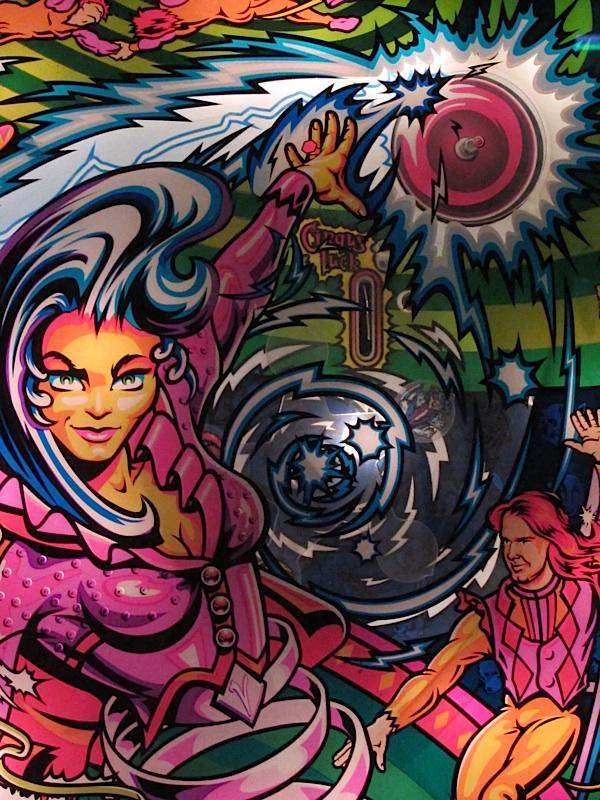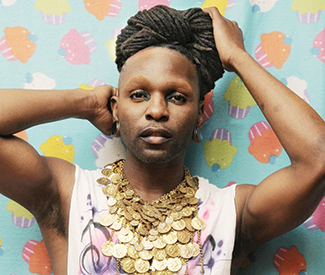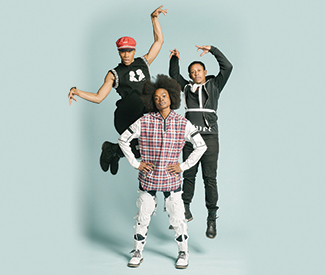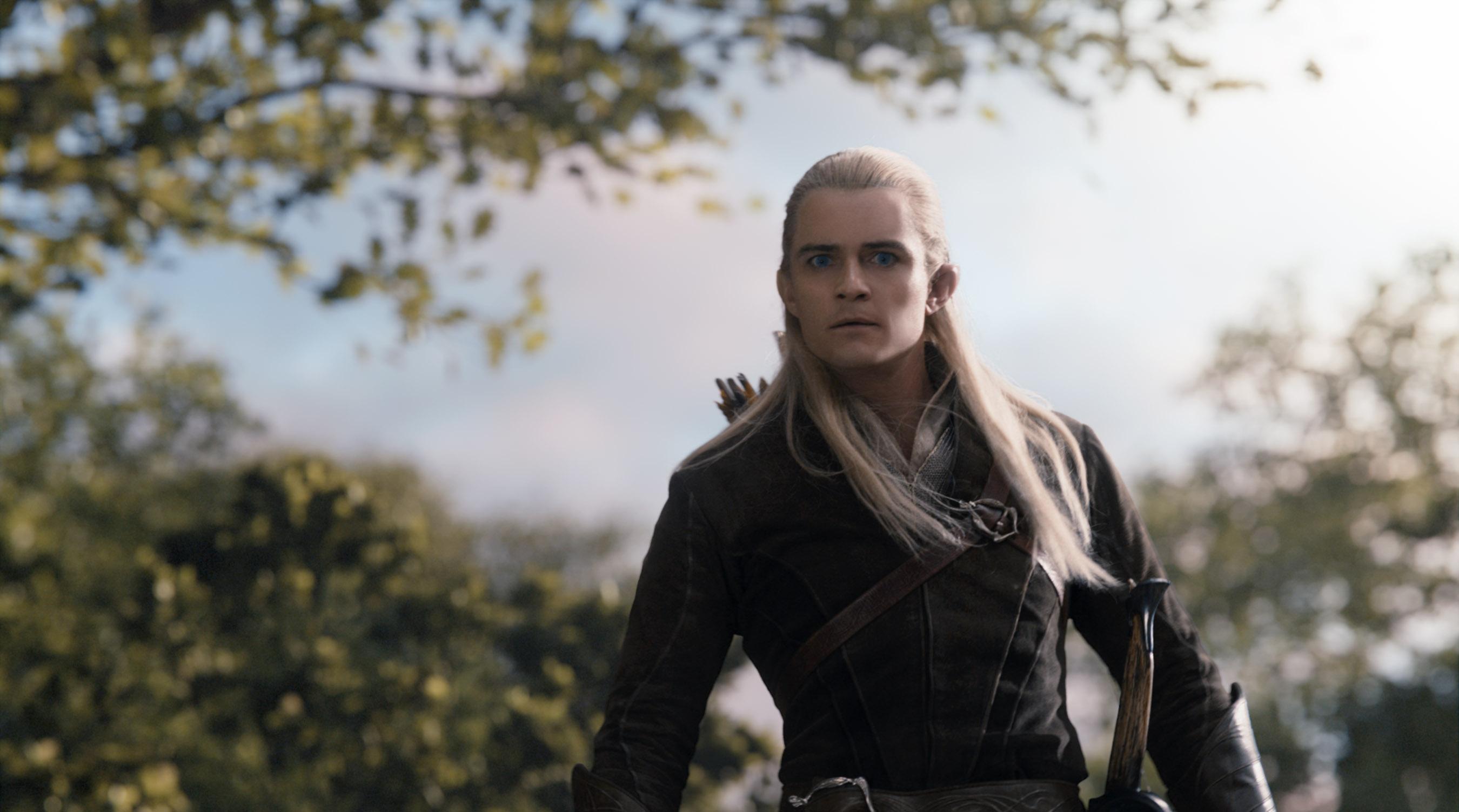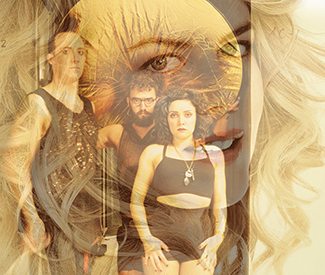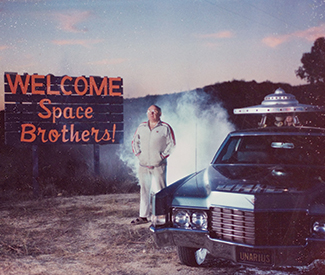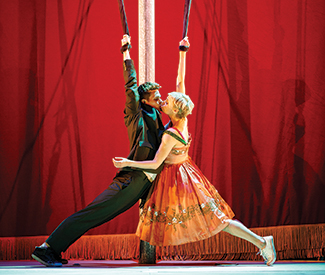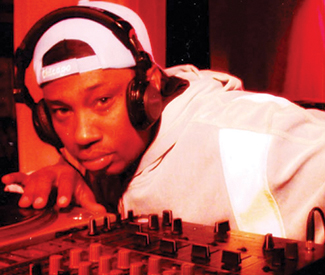WEDNESDAY 13
ROCK
Brick & Mortar Music Hall: 1710 Mission, San Francisco. Hot Toddies, Kill Moi, Odd Owl, Blaus, 9 p.m., $6-$9.
Cafe Du Nord: 2170 Market, San Francisco. “Thanks But No Thanksgiving,” Benefit for KUSF in Exile and One Mama featuring The Sam Chase, Jesús & The Rabbis, M.O.M. DJs, 9 p.m., $10-$15.
The Chapel: 777 Valencia St., San Francisco. Those Darlins, Diane Coffee, Jesus Sons, 9 p.m., $12-$15.
Elbo Room: 647 Valencia, San Francisco. Buffalo Tooth, Commissure, Growwler, Popgang DJs, 9 p.m., free.
Hemlock Tavern: 1131 Polk, San Francisco. White Mystery, Dead Meat, 8:30 p.m., $10.
Hotel Utah: 500 Fourth St., San Francisco. Grex, Cash Pony, Inner Ear Brigade, Mark Clifford Quartet, 8 p.m., $8-$10.
Monarch: 101 6th St., San Francisco. Tall Fires, Mosaics, Unruly Things, Stomping Grounds, 8 p.m., $8.
Thee Parkside: 1600 17th St., San Francisco. The Deer Tracks, Low Leaf, Survival Guide, 8 p.m., $10.
DANCE
The Cafe: 2369 Market, San Francisco. “Sticky Wednesdays,” w/ DJ Mark Andrus, 8 p.m., free.
Cat Club: 1190 Folsom, San Francisco. “Bondage A Go Go,” w/ DJs Damon, Tomas Diablo, & guests, 9:30 p.m., $5-$10.
Clift Hotel, Redwood Room: 495 Geary, San Francisco. “Enigma: Sessions 003,” w/ Reckless in Vegas, Dean Samaras, Richard Habib, Marija Dunn, 6 p.m., free.
Club X: 715 Harrison, San Francisco. “Electro Pop Rocks,” 18+ dance party with Gummy & Dosvec, 9 p.m.
Edinburgh Castle: 950 Geary, San Francisco. “1964,” w/ DJ Matt B & guests, Second and Fourth Wednesday of every month, 10 p.m., $2.
The EndUp: 401 Sixth St., San Francisco. “Tainted Techno Trance,” 10 p.m.
F8: 1192 Folsom St., San Francisco. “Housepitality,” w/ Francesca Lombardo, Michael Tello, Paul Carey, Mike Bee, Joel Conway, 9 p.m., $5-$10.
Harlot: 46 Minna, San Francisco. “Qoöl,” 5 p.m.
The Independent: 628 Divisadero, San Francisco. Thundercat, Real Magic, The Seshen, 8 p.m., $15-$17.
Infusion Lounge: 124 Ellis, San Francisco. “Indulgence,” 10 p.m.
The Knockout: 3223 Mission, San Francisco. “Disorder,” w/ Detachments, Replicanti, DJ Nickie, 10 p.m., $5.
Lookout: 3600 16th St., San Francisco. “What?,” w/ resident DJ Tisdale and guests, 7 p.m., free.
Madrone Art Bar: 500 Divisadero, San Francisco. “Rock the Spot,” 9 p.m., free.
MatrixFillmore: 3138 Fillmore, San Francisco. “Reload,” w/ DJ Big Bad Bruce, 10 p.m., free.
Q Bar: 456 Castro, San Francisco. “Booty Call,” w/ Juanita More, Joshua J, guests, 9 p.m., $3.
HIP-HOP
Double Dutch: 3192 16th St., San Francisco. “Cash IV Gold,” w/ DJs Kool Karlo, Roost Uno, and Sean G, 10 p.m., free.
Skylark Bar: 3089 16th St., San Francisco. “Mixtape Wednesday,” w/ resident DJs Strategy, Junot, Herb Digs, & guests, 9 p.m., $5.
ACOUSTIC
Cafe Divine: 1600 Stockton, San Francisco. Craig Ventresco & Meredith Axelrod, 7 p.m., free.
Club Deluxe: 1511 Haight, San Francisco. Happy Hour Bluegrass, 6:30 p.m., free.
Dolores Park Cafe: 501 Dolores, San Francisco. Joe Marson & Roem Baur, 6:30 p.m.
Johnny Foley’s Irish House: 243 O’Farrell St., San Francisco. Terry Savastano, Every other Wednesday, 9 p.m., free.
The Lost Church: 65 Capp St., San Francisco. Tall Heights, Jeff Conley, 8 p.m., $10.
Plough & Stars: 116 Clement, San Francisco. Daniel Seidel, 9 p.m.
Rickshaw Stop: 155 Fell, San Francisco. Farallons, Michael Musika, From a Fountain, 8 p.m., $10.
Swedish American Hall: 2174 Market, San Francisco. Vanessa Carlton, Birdcloud, 7:30 p.m., $25.
JAZZ
Amnesia: 853 Valencia, San Francisco. Gaucho, Eric Garland’s Jazz Session, The Amnesiacs, 7 p.m., free.
Burritt Room: 417 Stockton St., San Francisco. Terry Disley’s Rocking Jazz Trio, 6 p.m., free.
Center for New Music: 55 Taylor St., San Francisco. Peter Brötzmann & Paal Nilssen-Love, 7:30 p.m., $18-$28.
Jazz Bistro At Les Joulins: 44 Ellis, San Francisco. Charles Unger Experience, 7:30 p.m., free.
Le Colonial: 20 Cosmo, San Francisco. The Cosmo Alleycats featuring Ms. Emily Wade Adams, 7 p.m., free.
Savanna Jazz Club: 2937 Mission, San Francisco. “Cat’s Corner,” 9 p.m., $10.
Sheba Piano Lounge: 1419 Fillmore, San Francisco. Jesse Foster, 8 p.m.
Top of the Mark: One Nob Hill, 999 California, San Francisco. Ricardo Scales, Wednesdays, 6:30-11:30 p.m., $5.
Tupelo: 1337 Green St., San Francisco. Kit Ruscoe, 9:30 p.m.
Zingari: 501 Post, San Francisco. Sherri Roberts, 7:30 p.m., free.
INTERNATIONAL
Bissap Baobab: 3372 19th St., San Francisco. Timba Dance Party, w/ DJ WaltDigz, 10 p.m., $5.
Cafe Cocomo: 650 Indiana, San Francisco. “Bachatalicious,” w/ DJs Good Sho & Rodney, 7 p.m., $5-$10.
First Unitarian Universalist Society of San Francisco: 1187 Franklin, San Francisco. Kaoru Kakizakai with Shirley Kazuyo Muramoto, 7 p.m., $20.
Pachamama Restaurant: 1630 Powell, San Francisco. “Cafe LatinoAmericano,” 8 p.m., $5.
BLUES
Biscuits and Blues: 401 Mason, San Francisco. Alvon Johnson, 7:30 & 9:30 p.m., $15.
The Saloon: 1232 Grant, San Francisco. Leah Tysse, 9:30 p.m.
FUNK
Vertigo: 1160 Polk, San Francisco. “Full Tilt Boogie,” w/ KUSF-in-Exile DJs, Second Wednesday of every month, 8 p.m.-1:30 a.m., free.
SOUL
The Royal Cuckoo: 3202 Mission, San Francisco. Freddie Hughes & Chris Burns, 7:30 p.m., free.
THURSDAY 14
ROCK
Bottom of the Hill: 1233 17th St., San Francisco. 65daysofstatic, Caspian, The World Is a Beautiful Place & I Am No Longer Afraid to Die, 9 p.m., $15-$17.
Brick & Mortar Music Hall: 1710 Mission, San Francisco. The Besnard Lakes, Elephant Stone, 9 p.m., $13-$15.
S.F. Eagle: 398 12th St., San Francisco. Thursday Nite Live: Titan Ups, Bell Tower, The Hampton Wicks, 9 p.m., $8.
Hemlock Tavern: 1131 Polk, San Francisco. Slough Feg, Skeletor, Vulturegeist, 8:30 p.m., $10.
The Independent: 628 Divisadero, San Francisco. KMFDM, Chant, 8 p.m., $28-$30.
The Knockout: 3223 Mission, San Francisco. Vaz, Burmese, Donkee, 10 p.m., $8.
Thee Parkside: 1600 17th St., San Francisco. Alestorm, Trollfest, Gypsyhawk, Valensorow, 9 p.m., $20.
DANCE
1015 Folsom: 1015 Folsom St., San Francisco. “A Light in the Attic,” w/ Phutureprimitive, Unlimited Gravity, Soulular, Bedrockk, Evolutionista, Smash & Grab, 10 p.m., $5-$10 advance.
Abbey Tavern: 4100 Geary, San Francisco. DJ Schrobi-Girl, 10 p.m., free.
Audio Discotech: 316 11th St., San Francisco. “Phonic,” w/ Felix Cartal, Ron Reeser, more, 9:30 p.m., $10 advance.
Aunt Charlie’s Lounge: 133 Turk, San Francisco. “Tubesteak Connection,” w/ DJ Bus Station John, 9 p.m., $5-$7.
The Cafe: 2369 Market, San Francisco. “¡Pan Dulce!,” 9 p.m., $5.
Cat Club: 1190 Folsom, San Francisco. “Throwback Thursdays,” ‘80s night with DJs Damon, Steve Washington, Dangerous Dan, and guests, 9 p.m., $6 (free before 9:30 p.m.).
The Cellar: 685 Sutter, San Francisco. “XO,” w/ DJs Astro & Rose, 10 p.m., $5.
Club X: 715 Harrison, San Francisco. “The Crib,” 9:30 p.m., $10, 18+.
Danzhaus: 1275 Connecticut, San Francisco. “Alt.Dance,” Second Thursday of every month, 7 p.m., $7, 18+.
DNA Lounge: 375 11th St., San Francisco. “8bitSF,” w/ Crashfaster, Bit Shifter, Trash80, Unwoman, DJ Doctor Popular, 9 p.m., $10-$15.
Elbo Room: 647 Valencia, San Francisco. “Afrolicious,” w/ DJs Pleasuremaker, Señor Oz, and live guests, 9:30 p.m., $5-$8.
Harlot: 46 Minna, San Francisco. “Modular,” w/ Uner, JOill, Pedro Arbulu, MFYRS, 9 p.m., $7-$10.
Infusion Lounge: 124 Ellis, San Francisco. “I Love Thursdays,” 10 p.m., $10.
Madrone Art Bar: 500 Divisadero, San Francisco. “Night Fever,” 9 p.m., $5 after 10 p.m.
Public Works: 161 Erie, San Francisco. “Enigma,” w/ Butane, Stephanie, Marija Dunn, Amber Reyn, Richard Habib (in the OddJob Loft), 10 p.m., $10-$20 advance.
Q Bar: 456 Castro, San Francisco. “Throwback Thursday,” w/ DJ Jay-R, 9 p.m., free.
Raven: 1151 Folsom St., San Francisco. “1999,” w/ VJ Mark Andrus, 8 p.m., free.
Ruby Skye: 420 Mason, San Francisco. “Awakening,” w/ Danny Avila, Matisse Sadko, 9 p.m., $20-$25 advance.
The Tunnel Top: 601 Bush, San Francisco. “Tunneltop,” DJs Avalon and Derek ease you into the weekend with a cool and relaxed selection of tunes spun on vinyl, 10 p.m., free.
Underground SF: 424 Haight, San Francisco. “Bubble,” 10 p.m., free.
HIP-HOP
Eastside West: 3154 Fillmore, San Francisco. “Throwback Thursdays,” w/ DJ Madison, 9 p.m., free.
The EndUp: 401 Sixth St., San Francisco. “Cypher,” w/ resident DJ Big Von, 10 p.m., $5-$10.
John Colins: 138 Minna, San Francisco. “Party with Friends,” w/ resident DJs IllEfect, GeektotheBeat, Merrick, and Delrokz, Second Thursday of every month, 9 p.m., free.
Mezzanine: 444 Jessie, San Francisco. A$AP Ferg, A$AP Mob, Joey Fatts, Aston Matthews, 100s, DJ Sean G, 9 p.m., $20.
Milk Bar: 1840 Haight, San Francisco. Rime Force Most Illin’, Fatees, Al Lover, Height with Friends, DJ Brycon, 9 p.m., $5.
Park 77 Sports Bar: 77 Cambon, San Francisco. “Slap N Tite,” w/ resident Cali King Crab DJs Sabotage Beats & Jason Awesome, free.
Skylark Bar: 3089 16th St., San Francisco. “Peaches,” w/lady DJs DeeAndroid, Lady Fingaz, That Girl, Umami, Inkfat, and Andre, 10 p.m., free.
ACOUSTIC
Amnesia: 853 Valencia, San Francisco. Ghost & Gale, Lea Pruett, The Shants, 9 p.m., $7-$10.
Atlas Cafe: 3049 20th St., San Francisco. Gayle Lynn & The Hired Hands, 8 p.m., free.
Bazaar Cafe: 5927 California, San Francisco. Acoustic Open Mic, 7 p.m.
Boom Boom Room: 1601 Fillmore, San Francisco. Whitewater Ramble, Free Peoples, 9:30 p.m., $10.
Cafe Du Nord: 2170 Market, San Francisco. The Melodic, Steve Taylor Band, Sophia Knapp, 8:30 p.m., $12.
The Lost Church: 65 Capp St., San Francisco. Aireene & The Hobos, Deborah Crooks, 8 p.m., $10-$12.
Pa’ina: 1865 Post St., San Francisco. Ashley Lilinoe, 7 p.m., free.
Plough & Stars: 116 Clement, San Francisco. Emperor Norton Céilí Band, 9 p.m.
Yoshi’s San Francisco: 1330 Fillmore, San Francisco. An Evening with Graham Nash, 8 p.m., $89.
JAZZ
Blush! Wine Bar: 476 Castro, San Francisco. Doug Martin’s Avatar Ensemble, 7:30 p.m., free.
Bottle Cap: 1707 Powell, San Francisco. The North Beach Sound with Ned Boynton, Jordan Samuels, and Tom Vickers, 7 p.m., free.
Cafe Claude: 7 Claude, San Francisco. Mad & Eddie Duran Trio, 7:30 p.m., free.
Le Colonial: 20 Cosmo, San Francisco. Steve Lucky & The Rhumba Bums, 7:30 p.m.
The Royal Cuckoo: 3202 Mission, San Francisco. Charlie Siebert & Chris Burns, 7:30 p.m., free.
Savanna Jazz Club: 2937 Mission, San Francisco. Savanna Jazz Jam with Eddy Ramirez, 7:30 p.m., $5.
SFJAZZ Center: 205 Franklin St., San Francisco. “Hotplate,” w/ Tiffany Austin (playing Hoagy Carmichael), 8 & 9:30 p.m.
Top of the Mark: One Nob Hill, 999 California, San Francisco. Stompy Jones, 7:30 p.m., $10.
Zingari: 501 Post, San Francisco. Barbara Ochoa, 7:30 p.m., free.
INTERNATIONAL
Bissap Baobab: 3372 19th St., San Francisco. “Pa’Lante!,” w/ Juan G, El Kool Kyle, Mr. Lucky, 10 p.m., $5.
Cafe Cocomo: 650 Indiana, San Francisco. Danilo y Universal, DJ Good Sho, 8 p.m., $12.
Fort Mason, Southside Theater: Marina, San Francisco. Theatre Flamenco: Con Nombre y Apellido, The country’s oldest flamenco dance company celebrates its 47th home season., Nov. 14-16, 8 p.m.; Sun., Nov. 17, 2 p.m., $35-$75.
H Cafe: 3801 17th St., San Francisco. An Evening to Benefit the Duniya Center for Arts & Education, w/ Duniya Dance & Drum Company, Wontanara Revolution, Charlotte Nehm, Vanessa Sanchez, Naila, more, 6 p.m., $35-$80.
Pachamama Restaurant: 1630 Powell, San Francisco. “Jueves Flamencos,” 8 p.m., free.
Pier 23 Cafe: Pier 23, San Francisco. Armando Compean, 7 p.m., free.
Sheba Piano Lounge: 1419 Fillmore, San Francisco. Gary Flores & Descarga Caliente, 8 p.m.
Verdi Club: 2424 Mariposa, San Francisco. The Verdi Club Milonga, w/ Christy Coté, DJ Emilio Flores, guests, 9 p.m., $10-$15.
REGGAE
Make-Out Room: 3225 22nd St., San Francisco. “Festival ‘68,” w/ Revival Sound System, Second Thursday of every month, 10 p.m., free.
Pissed Off Pete’s: 4528 Mission St., San Francisco. Reggae Thursdays, w/ resident DJ Jah Yzer, 9 p.m., free.
BLUES
50 Mason Social House: 50 Mason, San Francisco. Bill Phillippe, 5:30 p.m., free.
Biscuits and Blues: 401 Mason, San Francisco. Nick Moss, 7:30 & 9:30 p.m., $20.
Jazz Bistro At Les Joulins: 44 Ellis, San Francisco. Bohemian Knuckleboogie, 7:30 p.m., free.
The Saloon: 1232 Grant, San Francisco. Tom Bowers, 4 p.m.; Steve Freund, 9:30 p.m.
COUNTRY
The Parlor: 2801 Leavenworth, San Francisco. “Twang Honky Tonk & Country Jamboree,” w/ DJ Little Red Rodeo, 7 p.m., free.
EXPERIMENTAL
The Luggage Store: 1007 Market, San Francisco. Capricious Forms Vol. 1, 8 p.m., $6-$10.
Yerba Buena Center for the Arts: 701 Mission, San Francisco. San Francisco Contemporary Music Players, 8 p.m., $12-$30.
FRIDAY 15
ROCK
Bottom of the Hill: 1233 17th St., San Francisco. Meat Puppets, The World Takes, 10 p.m., $17.
Brick & Mortar Music Hall: 1710 Mission, San Francisco. Golden Void, Hot Lunch, Harsh Toke, 9 p.m., $7-$10.
DNA Lounge: 375 11th St., San Francisco. Happy Fangs, Night Club, Everyone Is Dirty, Kat Haus, 8 p.m., $10.
El Rio: 3158 Mission, San Francisco. Friday Live: Down in Front, DJ Emotions, 10 p.m., free.
Hotel Utah: 500 Fourth St., San Francisco. The Bananas, Audacity, Hunters, Caldecott, 9 p.m., $10-$12.
Milk Bar: 1840 Haight, San Francisco. Part Time, Exray’s, Andy Human, Epicsauce DJs, 9 p.m., $10.
Rickshaw Stop: 155 Fell, San Francisco. Heroes and the Homo Superior: The Parables of Fancy Nancy, A “David Bowie superhero burlesque rock odyssey” featuring music by First Church of the Sacred Silversexual, burlesque routines by Hubba Hubba Revue, drag performances, and more., 9 p.m., $13.
Slim’s: 333 11th St., San Francisco. Alternative Tentacles 33 1/3 Anniversary Party, w/ Jello Biafra & The Guantanamo School of Medicine, Mojo Nixon, Death Hymn Number 9, Pins of Light., 8 p.m., $18.
Thee Parkside: 1600 17th St., San Francisco. That Ghost, FayRoy, Sons of Hippies, WAG, 9 p.m., $8.
DANCE
1015 Folsom: 1015 Folsom St., San Francisco. Rusko, Roni Size, Tonn Piper, Dynamite MC, Havoc, Ivry, Nebakaneza, Mr. Kitt, Johnny5, Danny Weird, Miss Haze, DJ Dials, Jays One, Audio-Troma, White Mike, Ryury., 10 p.m., $25 advance.
Audio Discotech: 316 11th St., San Francisco. Alex Sibley, Eelrack, Festiva, 9:30 p.m., $10 advance.
Cafe Flore: 2298 Market, San Francisco. “Kinky Beats,” w/ DJ Sergio, 10 p.m., free.
The Cafe: 2369 Market, San Francisco. “Boy Bar,” w/ DJ Matt Consola, 9 p.m., $5.
Cat Club: 1190 Folsom, San Francisco. “The Witching Hour,” w/ DJs Sage, Daniel Skellington, Joe Radio, and Nickie, 9:30 p.m., $7 ($3 before 10 p.m.).
The Cellar: 685 Sutter, San Francisco. “F.T.S.: For the Story,” 10 p.m.
The Chapel: 777 Valencia St., San Francisco. DJ Assault, Double Duchess, BadboE, Rapid Fire, 10 p.m., $10-$15.
DNA Lounge: 375 11th St., San Francisco. “So Stoked 13,” w/ Daniel Kandi, Ravine, Jimini Cricket, more, 7 p.m., $15-$25.
The EndUp: 401 Sixth St., San Francisco. “Fever,” 10 p.m., free before midnight.
The Grand Nightclub: 520 4th St., San Francisco. “We Rock Fridays,” 9:30 p.m.
Infusion Lounge: 124 Ellis, San Francisco. “Escape Fridays,” 10 p.m., $20.
Lookout: 3600 16th St., San Francisco. “HYSL,” 9 p.m., $3.
Madrone Art Bar: 500 Divisadero, San Francisco. “That ‘80s Show,” w/ DJs Dave Paul & Jeff Harris, Third Friday of every month, 9 p.m., $5.
Manor West: 750 Harrison, San Francisco. “Fortune Fridays,” 10 p.m., free before 11 p.m. with RSVP.
MatrixFillmore: 3138 Fillmore, San Francisco. “F-Style Fridays,” w/ DJ Jared-F, 9 p.m.
Mezzanine: 444 Jessie, San Francisco. “Fools in the Night,” w/ Ladyhawke (DJ set), American Royalty, Blackbird Blackbird, Aaron Axelsen, 9 p.m., $15.
Mighty: 119 Utah, San Francisco. “Masters at Work,” w/ Kenny Dope & Louie Vega, 9 p.m., $20-$50.
OMG: 43 6th St., San Francisco. “Release,” 9 p.m., free before 11 p.m.
Public Works: 161 Erie, San Francisco. “Odyssey,” w/ Rick Preston, Robin Simmons, Trevor Sigler (in the OddJob Loft), 9:30 p.m., $10.
Q Bar: 456 Castro, San Francisco. “Pump: Worq It Out Fridays,” w/ resident DJ Christopher B, 9 p.m., $3.
Ruby Skye: 420 Mason, San Francisco. Arnej, Bobina, Dirtyhertz, 9 p.m., $20 advance.
Slate Bar: 2925 16th St., San Francisco. “Darling Nikki,” w/ resident DJs Dr. Sleep, Justin Credible, and Durt, Third Friday of every month, 8 p.m., $5.
Sub-Mission Art Space (Balazo 18 Gallery): 2183 Mission, San Francisco. “Deathrock Night Terrors,” w/ The Frozen Autumn, V.E.X., Red Light, plus DJs Le Perv, Necromos, and Burning Skies, 8:30 p.m., $12-$15.
Temple: 540 Howard, San Francisco. “Refresh,” w/ Pedro Arbulu, Chemical Ali, David Gregory, DJ Tone, DJ Von, 10 p.m., $15.
Underground SF: 424 Haight, San Francisco. “Bionic,” 10 p.m., $5.
Vessel: 85 Campton, San Francisco. Dirty South, 10 p.m.
Wish: 1539 Folsom, San Francisco. “Bridge the Gap,” w/ resident DJ Don Kainoa, Fridays, 6-10 p.m., free; “Depth,” w/ resident DJs Sharon Buck & Greg Yuen, Third Friday of every month, 10 p.m., free.
HIP-HOP
EZ5: 682 Commercial, San Francisco. “Decompression,” Fridays, 5-9 p.m.
The Independent: 628 Divisadero, San Francisco. Big Freedia, 9 p.m., $20.
John Colins: 138 Minna, San Francisco. “Juicy,” w/ DJ Ry Toast, Third Friday of every month, 10 p.m., $5 (free before 11 p.m.).
Showdown: 10 Sixth St., San Francisco. BPos, Mo Classics, Monk McNizzle, 9 p.m., free.
Yoshi’s San Francisco: 1330 Fillmore, San Francisco. Sir Mix-A-Lot, 10:30 p.m., $18-$22.
ACOUSTIC
Amnesia: 853 Valencia, San Francisco. SnowApple, 7 p.m.
Bazaar Cafe: 5927 California, San Francisco. The Canon Band, 7 p.m.
Cafe Du Nord: 2170 Market, San Francisco. Megan Slankard, Tom Freund, Wafflebarrel, 9 p.m., $15.
Mercury Cafe: 201 Octavia, San Francisco. Toshio Hirano, Third Friday of every month, 7:30 p.m., free, all ages.
Plough & Stars: 116 Clement, San Francisco. “Bluegrass Bonanza,” w/ Travers Chandler & Avery County, Belle Monroe & Her Brewglass Boys, 9 p.m., $6-$10.
Red Poppy Art House: 2698 Folsom, San Francisco. Amy LaCour with Ross Hammond, 7:30 p.m., $10-$15.
The Sports Basement: 610 Old Mason, San Francisco. “Breakfast with Enzo,” w/ Enzo Garcia, 10 a.m., $5.
Yoshi’s San Francisco: 1330 Fillmore, San Francisco. An Evening with Mason Jennings, 8 p.m., $29.
JAZZ
Beach Chalet Brewery & Restaurant: 1000 Great Highway, San Francisco. Johnny Smith, 8 p.m., free.
Bird & Beckett: 653 Chenery, San Francisco. The Third Quartet, Third Friday of every month, 5:30 p.m., free.
Cafe Claude: 7 Claude, San Francisco. Nick Rossi Trio, 9:30 p.m., free.
City College: 50 Phelan, San Francisco. The Cartoon Jazz Band, 7:30 p.m., free.
Jazz Bistro At Les Joulins: 44 Ellis, San Francisco. Charles Unger Experience, 7:30 p.m., free.
The Palace Hotel: 2 New Montgomery, San Francisco. The Klipptones, 8 p.m., free.
Revolution Cafe: 3248 22nd St., San Francisco. Emily Anne’s Delights, Third Friday of every month, 8:45 p.m., free/donation.
Savanna Jazz Club: 2937 Mission, San Francisco. Jim Butler Group, 7:30 p.m., $8.
SFJAZZ Center: 205 Franklin St., San Francisco. Pamela Rose & Wayne De La Cruz, 7 & 8:30 p.m., $25.
Sheba Piano Lounge: 1419 Fillmore, San Francisco. Sam Caddy Quintet, 9 p.m.
Top of the Mark: One Nob Hill, 999 California, San Francisco. Black Market Jazz Orchestra, 9 p.m., $10.
Zingari: 501 Post, San Francisco. Joyce Grant, 8 p.m., free.
INTERNATIONAL
Bissap Baobab: 3372 19th St., San Francisco. Qumbia Qrew, Third Friday of every month, 8 p.m.; “Paris-Dakar African Mix Coupe Decale,” 10 p.m., $5.
Cafe Cocomo: 650 Indiana, San Francisco. Taste Fridays, featuring local cuisine tastings, salsa bands, dance lessons, and more, 7:30 p.m., $15 (free entry to patio).
Cigar Bar & Grill: 850 Montgomery, San Francisco. Orquesta La Clave, 8 p.m.
Fort Mason, Southside Theater: Marina, San Francisco. Theatre Flamenco: Con Nombre y Apellido, The country’s oldest flamenco dance company celebrates its 47th home season., Nov. 14-16, 8 p.m.; Sun., Nov. 17, 2 p.m., $35-$75.
Pachamama Restaurant: 1630 Powell, San Francisco. Cuban Night with Fito Reinoso, 7:30 & 9:15 p.m., $15-$18.
Pier 23 Cafe: Pier 23, San Francisco. Armando Compean, 8 p.m., free.
Public Works: 161 Erie, San Francisco. Afrolicious Band, J-Boogie, 10 p.m., $10.
REGGAE
Elbo Room: 647 Valencia, San Francisco. “The Social,” w/ Native Elements, Jah Yzer, 10 p.m., $10.
Gestalt Haus: 3159 16th St., San Francisco. “Music Like Dirt,” 7:30 p.m., free.
BLUES
Biscuits and Blues: 401 Mason, San Francisco. Kevin Selfe & The Tornadoes, 7:30 & 10 p.m., $20.
The Saloon: 1232 Grant, San Francisco. West Coast Blues Revue, 4 p.m.; Cathy Lemons, 9:30 p.m.
FUNK
Amnesia: 853 Valencia, San Francisco. “Hella Tight,” w/ resident DJs Vinnie Esparza, Jonny Deeper, & Asti Spumanti, Third Friday of every month, 10 p.m., $5.
Dolores Park Cafe: 501 Dolores, San Francisco. Shake It! Booty Band, 7:30 p.m.
Make-Out Room: 3225 22nd St., San Francisco. “Loose Joints,” w/ DJs Centipede, Damon Bell, & Tom Thump, 10 p.m., $5.
SOUL
Edinburgh Castle: 950 Geary, San Francisco. “Soul Crush,” w/ DJ Serious Leisure, 10 p.m., free.
The Knockout: 3223 Mission, San Francisco. “Oldies Night,” W/ DJs Primo, Daniel, Lost Cat, and friends, Third Friday of every month, 10 p.m., $5.
SATURDAY 16
ROCK
Bender’s: 806 S. Van Ness, San Francisco. Moses, Hornss, 10 p.m., $5.
Bottom of the Hill: 1233 17th St., San Francisco. Quasi, Blues Control, Street Eaters, 9:30 p.m., $15.
Brick & Mortar Music Hall: 1710 Mission, San Francisco. Someone Still Loves You Boris Yeltsin, Army Navy, 9 p.m., $12-$15.
Cafe Du Nord: 2170 Market, San Francisco. San Francisco Food Bank Benefit with Tommy Guerrero & Friends, El Diablitos, DJ Romanowski, 9:30 p.m., $10-$15.
The Chapel: 777 Valencia St., San Francisco. Cellar Doors, 9 p.m., $12.
El Rio: 3158 Mission, San Francisco. Benefit for Family Dog Rescue with The Shams, The Next, The Unfortunate Bastard, Psychokitty, 9 p.m.
Hemlock Tavern: 1131 Polk, San Francisco. Guantanamo Baywatch, Death Hymn Number 9, Buffalo Tooth, Pookie & The Poodlez, 8:30 p.m., $7.
Hotel Utah: 500 Fourth St., San Francisco. “Rocket Ship!,” w/ Starr Saunders, The Coffis Brothers, Exhausted Pipes, Katie Ekin, 9 p.m., $8-$12.
Rickshaw Stop: 155 Fell, San Francisco. Tera Melos, Zorch, Sister Crayon, Creepers, 9 p.m., $15.
Slim’s: 333 11th St., San Francisco. Born Ruffians, Grmln, 9 p.m., $17.
Thee Parkside: 1600 17th St., San Francisco. Fog of War, Nekrofilth, Burning Monk, Tomes, 9:30 p.m., $8.
DANCE
Amnesia: 853 Valencia, San Francisco. “Pance Darty,” w/ Jjaaxxnn & Duke, Third Saturday of every month, 9 p.m., $7.
Audio Discotech: 316 11th St., San Francisco. Miguel Migs, Andrew Phelan, 9:30 p.m., $10 advance.
Balancoire: 2565 Mission St., San Francisco. “Play It Cool,” w/ Boogie Nite, Avalon Emerson, Derek Opperman, Guillaume Galuz, Matthew Favorites, 9 p.m., $5.
BeatBox: 314 11th St., San Francisco. “I Just Wanna F*ckin Dance,” w/ DJs Hector Fonseca & Chi Chi LaRue, 10 p.m., $15-$25.
Cafe Flore: 2298 Market, San Francisco. “Bistrotheque,” w/ DJ Ken Vulsion, 8 p.m., free.
Cat Club: 1190 Folsom, San Francisco. “New Wave City: Duran Duran Video Night,” w/ DJs Shindog, Andy T, B.A.D. Reputation, and Girl Panic, 9 p.m., $7-$12.
DNA Lounge: 375 11th St., San Francisco. “Bootie S.F.,” w/ DJ Tripp, Entyme, Meikee Magnetic, Mixtress Shizaam, Dcnstrct, MyKill, Hubba Hubba Revue, more, 9 p.m., $10-$15.
The EndUp: 401 Sixth St., San Francisco. “The Show,” w/ Ben Seagren, Dean Samaras, and guests (starts 2 a.m. Sunday morning), Third Saturday of every month, $10-$20 (free before 11 p.m.).
F8: 1192 Folsom St., San Francisco. “Hegemoney,” w/ Mr. Carmack, Insightful, Mikos Da Gawd, Bobby Peru, Starter Kit, 9 p.m., $10-$15.
Infusion Lounge: 124 Ellis, San Francisco. “Social Addiction,” Third Saturday of every month, 10 p.m., $20.
Lookout: 3600 16th St., San Francisco. “Bounce!,” 9 p.m., $3.
Madrone Art Bar: 500 Divisadero, San Francisco. “Fringe,” w/ DJs Blondie K & subOctave, Third Saturday of every month, 9 p.m., $5 (free before 10 p.m.).
Mighty: 119 Utah, San Francisco. “Mighty Real,” w/ Tiga, Bells & Whistles, David Harness, 10 p.m., $15 advance.
Milk Bar: 1840 Haight, San Francisco. “The Queen Is Dead: A Tribute to the Music of Morrissey & The Smiths,” w/ DJ Mario Muse & guests, Third Saturday of every month, 9 p.m.
Monarch: 101 6th St., San Francisco. “Lights Down Low,” w/ MK, Richie Panic, Sleazemore, MPHD, 10 p.m., $15-$20.
Powerhouse: 1347 Folsom, San Francisco. “Beatpig,” Third Saturday of every month, 9 p.m.
Project One: 251 Rhode Island, San Francisco. “Familia vs. Friends and Family,” w/ Lee Coombs, Ethan Miller, Ding Dong, Tamo, Nugz, 9 p.m., $10-$15 advance.
Public Works: 161 Erie, San Francisco. “Isis,” w/ PBR Streetgang, Mountaincount (in the OddJob Loft), 9:30 p.m., $10-$15.
Ruby Skye: 420 Mason, San Francisco. “World Town,” w/ Deorro, Trevor Simpson, 9 p.m., $20 advance.
Slate Bar: 2925 16th St., San Francisco. “Smiths Night S.F.,” w/ The Certain People Crew, Third Saturday of every month, 10 p.m., $5.
Slide: 430 Mason, San Francisco. “Luminous,” w/ DJ Zhaldee, Third Saturday of every month, 9 p.m.
Supperclub San Francisco: 657 Harrison, San Francisco. “Scorpio’s Ball,” w/ El Papa Chango, Smasheltooth, Jocelyn, Portal, 9 p.m., $10-$20.
Vessel: 85 Campton, San Francisco. Tall Sasha, 10 p.m., $10-$30.
HIP-HOP
111 Minna Gallery: 111 Minna St., San Francisco. “Shine,” Third Saturday of every month, 10 p.m.
John Colins: 138 Minna, San Francisco. “The Bump,” w/ The Whooligan, Third Saturday of every month, 10 p.m., free.
The Knockout: 3223 Mission, San Francisco. “The Booty Bassment,” w/ DJs Dimitri Dickinson & Ryan Poulsen, Third Saturday of every month, 10 p.m., $5.
Mezzanine: 444 Jessie, San Francisco. Spawnbreezie, BigBody Cisco, Drew Deezy, 9 p.m., $20.
Showdown: 10 Sixth St., San Francisco. “Purple,” w/ resident DJs ChaunceyCC & Party Pablo, Third Saturday of every month, 10 p.m.
ACOUSTIC
Amoeba Music: 1855 Haight, San Francisco. Mason Jennings, 3 p.m., free.
Atlas Cafe: 3049 20th St., San Francisco. Craig Ventresco & Meredith Axelrod, Saturdays, 4-6 p.m., free.
Bazaar Cafe: 5927 California, San Francisco. Paul Griffiths, 7 p.m.
The Independent: 628 Divisadero, San Francisco. Vienna Teng, 6 & 9 p.m., $25.
The Lost Church: 65 Capp St., San Francisco. North Home, Jean Marie, 8 p.m., $10.
Plough & Stars: 116 Clement, San Francisco. John Haesemeyer, Jeff Hayward, RonDre., 8 p.m., $6.
The Riptide: 3639 Taraval, San Francisco. Chris James & The Showdowns, 9:30 p.m., free.
St. Cyprian’s Episcopal Church: 2097 Turk, San Francisco. A Musical Tribute & Celebration of the Life & Songs of Phil Ochs, featuring Sonny Ochs, Kim & Reggie Harris, Carolyn Hester, James Lee Stanley, and Aileen Vance, 8 p.m., $17-$20.
Tupelo: 1337 Green St., San Francisco. Shantytown, 9 p.m.
Yoshi’s San Francisco: 1330 Fillmore, San Francisco. An Evening with Mason Jennings, 8 & 10 p.m., $24-$29.
JAZZ
Cafe Claude: 7 Claude, San Francisco. The Monroe Trio, 7:30 p.m., free.
Jazz Bistro At Les Joulins: 44 Ellis, San Francisco. Bill “Doc” Webster & Jazz Nostalgia, 7:30 p.m., free.
The Royal Cuckoo: 3202 Mission, San Francisco. Jules Broussard, Danny Armstrong, and Chris Siebert, 7:30 p.m., free.
Savanna Jazz Club: 2937 Mission, San Francisco. Lily Alunan, 7:30 p.m., $10.
SFJAZZ Center: 205 Franklin St., San Francisco. Wesla Whitfield, 7 & 8:30 p.m., $30.
Sheba Piano Lounge: 1419 Fillmore, San Francisco. The Robert Stewart Experience, 9 p.m.
Zingari: 501 Post, San Francisco. Brenda Reed, 8 p.m., free.
INTERNATIONAL
1015 Folsom: 1015 Folsom St., San Francisco. “Pura,” 9 p.m., $20.
Bissap Baobab: 3372 19th St., San Francisco. “Paris-Dakar African Mix Coupe Decale,” 10 p.m., $5.
Cafe Cocomo: 650 Indiana, San Francisco. Peruvian Salsa Showdown, w/ Pepe y Su Orquesta vs. Julio Bravo y Su Orquesta Salsabor, 8 p.m., $15.
Cigar Bar & Grill: 850 Montgomery, San Francisco. Conjunto Picante, 8 p.m.
Fort Mason, Southside Theater: Marina, San Francisco. Theatre Flamenco: Con Nombre y Apellido, The country’s oldest flamenco dance company celebrates its 47th home season., Nov. 14-16, 8 p.m.; Sun., Nov. 17, 2 p.m., $35-$75.
Make-Out Room: 3225 22nd St., San Francisco. “El SuperRitmo,” w/ DJs Roger Mas & El Kool Kyle, 10 p.m., $5.
OMG: 43 6th St., San Francisco. “Bollywood Blast,” Third Saturday of every month, 9 p.m., $5 (free before 10:30 p.m.).
Pachamama Restaurant: 1630 Powell, San Francisco. Peña Eddy Navia & Pachamama Band, 8 p.m., free.
Public Works: 161 Erie, San Francisco. “Non Stop Bhangra,” w/ Jimmy Love, Rav-E, Pavit, Mehul, Dholrhythms dance troupe, more (in the main room), 9 p.m., $10-$15.
Red Poppy Art House: 2698 Folsom, San Francisco. Makrú, 7:30 p.m., $10-$15.
Revolution Cafe: 3248 22nd St., San Francisco. Go Van Gogh, Third Saturday of every month, 9 p.m., free/donation.
Roccapulco Supper Club: 3140 Mission, San Francisco. Farruko, 8 p.m., $40 advance.
BLUES
Biscuits and Blues: 401 Mason, San Francisco. Paula Harris, 7:30 & 10 p.m., $20.
Pier 23 Cafe: Pier 23, San Francisco. Bobbie Webb, 8 p.m., free.
The Saloon: 1232 Grant, San Francisco. Tony Perez & Second Hand Smoke, Third Saturday of every month, 4 p.m.; Nick Gravenites, 9:30 p.m.
EXPERIMENTAL
Columbarium: One Loraine Court, San Francisco. Luciano Chessa: Lightest, 6 p.m., free.
FUNK
Boom Boom Room: 1601 Fillmore, San Francisco. Polyrhythmics, Ideateam, 9:30 p.m., $10-$15.
SOUL
Elbo Room: 647 Valencia, San Francisco. “Saturday Night Soul Party,” w/ DJs Lucky, Phengren Oswald, and Paul Paul, Third Saturday of every month, 10 p.m., $10 ($5 in formal attire).
SUNDAY 17
ROCK
Bottom of the Hill: 1233 17th St., San Francisco. The Grannies, Winter Teeth, Bar Fight, 7 p.m., $10.
Cafe Du Nord: 2170 Market, San Francisco. Grant Farm, Emily Yates, Misisipi Mike Wolf, 8 p.m., $12.
Hemlock Tavern: 1131 Polk, San Francisco. Pop. 1280, 8:30 p.m., $7.
The Independent: 628 Divisadero, San Francisco. Anna Calvi, Sandy’s, 8 p.m., $20.
Milk Bar: 1840 Haight, San Francisco. Corners, Froth, Adult Books, Bicycle Day, 8 p.m., $5.
Neck of the Woods: 406 Clement St., San Francisco. Cadaver Dogs, MoonFox, A Happy Death, 8 p.m., $5-$8.
Rickshaw Stop: 155 Fell, San Francisco. White Lung, Antwon, Tony Molina, 7 p.m., $10-$12.
Slim’s: 333 11th St., San Francisco. Tonight Alive, The Downtown Fiction, For the Foxes, Echosmith, 7 p.m., $14.
DANCE
BeatBox: 314 11th St., San Francisco. “Tea-Rex,” w/ DJ Corey Craig, 4-8 p.m., $5-$10.
The Cellar: 685 Sutter, San Francisco. “Replay Sundays,” 9 p.m., free.
The Edge: 4149 18th St., San Francisco. “’80s at 8,” w/ DJ MC2, 8 p.m.
Elbo Room: 647 Valencia, San Francisco. “Dub Mission,” w/ Roger Mas, DJ Sep, Vinnie Esparza, 9 p.m., $6 (free before 9:30 p.m.).
The EndUp: 401 Sixth St., San Francisco. “T.Dance,” 6 a.m.-6 p.m.; “Soul Affair,” Third Sunday of every month, 8 p.m.; “Sunday Sessions,” 8 p.m.
F8: 1192 Folsom St., San Francisco. “Stamina Sundays,” w/ DLR & Adept, 10 p.m., free.
The Knockout: 3223 Mission, San Francisco. “Sweater Funk,” 10 p.m., free.
Lookout: 3600 16th St., San Francisco. “Jock,” Sundays, 3-8 p.m., $2.
MatrixFillmore: 3138 Fillmore, San Francisco. “Bounce,” w/ DJ Just, 10 p.m.
Monarch: 101 6th St., San Francisco. “Reload,” 9:30 p.m., $5; “Reload,” 9:30 p.m., $5.
Otis: 25 Maiden, San Francisco. “What’s the Werd?,” w/ resident DJs Nick Williams, Kevin Knapp, Maxwell Dub, and guests, 9 p.m., $5 (free before 11 p.m.).
The Parlor: 2801 Leavenworth, San Francisco. DJ Marc deVasconcelos, 10 p.m., free.
Q Bar: 456 Castro, San Francisco. “Gigante,” 8 p.m., free.
Showdown: 10 Sixth St., San Francisco. “The Dark Wave Rises,” w/ DJ Xtine Noir & DJ From Full House, Third Sunday of every month, 10 p.m.
Slate Bar: 2925 16th St., San Francisco. “She Said…: A Queer Affair,” Third Sunday of every month, 4 p.m., $3-$5.
HIP-HOP
Boom Boom Room: 1601 Fillmore, San Francisco. “Return of the Cypher,” 9:30 p.m., free.
Brick & Mortar Music Hall: 1710 Mission, San Francisco. Chuck Inglish, Kings Dead, Sayknowledge, Young Gully, Nick Jame$, Symba, 9 p.m., $12-$15.
ACOUSTIC
Hotel Utah: 500 Fourth St., San Francisco. Donovan Plant Band, Ian Franklin & Infinite Frequency, Jeff Desira, Ray Vaughn, Benjamin Brown, 8 p.m., $8-$10.
The Lucky Horseshoe: 453 Cortland, San Francisco. Sunday Bluegrass Jam, 4 p.m., free.
Madrone Art Bar: 500 Divisadero, San Francisco. “Spike’s Mic Night,” Sundays, 4-8 p.m., free.
Neck of the Woods: 406 Clement St., San Francisco. “iPlay,” open mic with featured weekly artists, 6:30 p.m., free.
Plough & Stars: 116 Clement, San Francisco. Seisiún with Darcy Noonan, Richard Mandel, and Jack Gilder, 9 p.m.
St. Luke’s Episcopal Church: 1755 Clay, San Francisco. “Sunday Night Mic,” w/ Roem Baur, 5 p.m., free.
Tupelo: 1337 Green St., San Francisco. The West Nile Ramblers, 9 p.m.
JAZZ
Biscuits and Blues: 401 Mason, San Francisco. Macy Blackman, 7:30 & 9:30 p.m., $15.
Chez Hanny: 1300 Silver, San Francisco. Scott Amendola Quartet, 4 p.m., $20 suggested donation.
Jazz Bistro At Les Joulins: 44 Ellis, San Francisco. Bill “Doc” Webster & Jazz Nostalgia, 7:30 p.m., free.
Madrone Art Bar: 500 Divisadero, San Francisco. “Sunday Sessions,” 10 p.m., free.
Revolution Cafe: 3248 22nd St., San Francisco. Jazz Revolution, 4 p.m., free/donation.
The Riptide: 3639 Taraval, San Francisco. The Cottontails, Third Sunday of every month, 7:30 p.m., free.
The Royal Cuckoo: 3202 Mission, San Francisco. Lavay Smith & Chris Siebert, 7:30 p.m., free.
SFJAZZ Center: 205 Franklin St., San Francisco. Jackie Ryan, 5:30 & 7 p.m., $20.
Zingari: 501 Post, San Francisco. Amanda Addleman, 7:30 p.m., free.
INTERNATIONAL
Atmosphere: 447 Broadway, San Francisco. “Hot Bachata Nights,” w/ DJ El Guapo, 5:30 p.m., $10 ($18-$25 with dance lessons).
Bissap Baobab: 3372 19th St., San Francisco. “Brazil & Beyond,” 6:30 p.m., free.
Fort Mason, Southside Theater: Marina, San Francisco. Theatre Flamenco: Con Nombre y Apellido, The country’s oldest flamenco dance company celebrates its 47th home season., Nov. 14-16, 8 p.m.; Sun., Nov. 17, 2 p.m., $35-$75.
Old First Presbyterian Church: 1751 Sacramento, San Francisco. Shoko Hikage with Thomas Schultz & Narae Kwon, 4 p.m., $14-$17.
Thirsty Bear Brewing Company: 661 Howard, San Francisco. “The Flamenco Room,” 7:30 & 8:30 p.m.
REGGAE
Mezzanine: 444 Jessie, San Francisco. Shaggy, Rayvon, Thrive, DJ Green B, 9 p.m., $25.
Pa’ina: 1865 Post St., San Francisco. Siaosi, Kiwini Vaitai, Jasmine Lee, 7 p.m., $10.
BLUES
Amnesia: 853 Valencia, San Francisco. HowellDevine, Third Sunday of every month, 8:30 p.m., $7-$10.
Lou’s Fish Shack: 300 Jefferson St., San Francisco. Nat Bolden, 4 p.m.
Revolution Cafe: 3248 22nd St., San Francisco. HowellDevine, 8:30 p.m., free/donation.
The Saloon: 1232 Grant, San Francisco. Blues Power, 4 p.m.; Silvia C, 9:30 p.m.
Sheba Piano Lounge: 1419 Fillmore, San Francisco. Bohemian Knuckleboogie, 8 p.m., free.
Swig: 571 Geary, San Francisco. Sunday Blues Jam with Ed Ivey, 9 p.m.
EXPERIMENTAL
El Rio: 3158 Mission, San Francisco. Marielle Jakobsons, Tecumseh, Names, 8 p.m., $7.
The Lab: 2948 16th St., San Francisco. “Godwaffle Noise Pancakes,” w/ Medicine Cabinet, Dictionary of Ghosts, Beast Nest, Rent Romus, Moo Kau, noon, $5-$10.
Musicians Union Local 6: 116 Ninth St., San Francisco. The Reckoning Quartet, Skullkrusher, 7:30 p.m., $8-$10.
SOUL
Delirium Cocktails: 3139 16th St., San Francisco. “Heart & Soul,” w/ DJ Lovely Lesage, 10 p.m., free.
MONDAY 18
ROCK
Brick & Mortar Music Hall: 1710 Mission, San Francisco. Social Studies, Foli, The Tropics, 9 p.m., $6.
The Chapel: 777 Valencia St., San Francisco. Nightlands, 8 p.m., $12.
Slim’s: 333 11th St., San Francisco. Wire, Chastity Belt, 8 p.m., $25.
DANCE
DNA Lounge: 375 11th St., San Francisco. “Death Guild,” 18+ dance party with DJs Decay, Joe Radio, Melting Girl, & guests, 9:30 p.m., $3-$5.
Q Bar: 456 Castro, San Francisco. “Wanted,” w/ DJs Key&Kite and Richie Panic, 9 p.m., free.
Underground SF: 424 Haight, San Francisco. “Vienetta Discotheque,” w/ DJs Stanley Frank and Robert Jeffrey, 10 p.m., free.
HIP-HOP
Elbo Room: 647 Valencia, San Francisco. Travaille, Ickymack, Cozmost, 9 p.m.
ACOUSTIC
Amnesia: 853 Valencia, San Francisco. Windy Hill, Third Monday of every month, 9 p.m., free.
Bazaar Cafe: 5927 California, San Francisco. West Coast Songwriters Competition, 7 p.m.
Cafe Du Nord: 2170 Market, San Francisco. Lindi Ortega, Brett Detar, 8:30 p.m., $12.
The Chieftain: 198 Fifth St., San Francisco. The Wrenboys, 7 p.m., free.
Fiddler’s Green: 1333 Columbus, San Francisco. Terry Savastano, 9:30 p.m., free/donation.
Hotel Utah: 500 Fourth St., San Francisco. Open mic with Brendan Getzell, 8 p.m., free.
Make-Out Room: 3225 22nd St., San Francisco. “Sad Bastard Club,” Third Monday of every month, 7:30 p.m., free.
Osteria: 3277 Sacramento, San Francisco. “Acoustic Bistro,” 7 p.m., free.
The Saloon: 1232 Grant, San Francisco. Peter Lindman, 4 p.m.
JAZZ
Cafe Divine: 1600 Stockton, San Francisco. Rob Reich, First and Third Monday of every month, 7 p.m.
Le Colonial: 20 Cosmo, San Francisco. Le Jazz Hot, 7 p.m., free.
Sheba Piano Lounge: 1419 Fillmore, San Francisco. City Jazz Instrumental Jam Session, 8 p.m.
The Union Room at Biscuits and Blues: 401 Mason, San Francisco. The Session: A Monday Night Jazz Series, pro jazz jam with Mike Olmos, 7:30 p.m., $12.
Zingari: 501 Post, San Francisco. Nora Maki, 7:30 p.m., free.
REGGAE
Skylark Bar: 3089 16th St., San Francisco. “Skylarking,” w/ I&I Vibration, 10 p.m., free.
BLUES
Biscuits and Blues: 401 Mason, San Francisco. Craig Horton, 7:30 & 9:30 p.m., $15.
Jazz Bistro At Les Joulins: 44 Ellis, San Francisco. Bohemian Knuckleboogie, 7:30 p.m., free.
The Saloon: 1232 Grant, San Francisco. The Bachelors, 9:30 p.m.
SOUL
Madrone Art Bar: 500 Divisadero, San Francisco. “M.O.M. (Motown on Mondays),” w/ DJ Gordo Cabeza & Timoteo Gigante, 8 p.m., free.
TUESDAY 19
ROCK
Amnesia: 853 Valencia, San Francisco. French Cassettes, Black Cobra Vipers, Eagle, 9:15 p.m., $7.
Boom Boom Room: 1601 Fillmore, San Francisco. The Bennys, Big Sticky Mess, Glimpse Trio, 9:30 p.m., $5.
Bottom of the Hill: 1233 17th St., San Francisco. Obits, Rob Crow’s Gloomy Place, Pins of Light, 9 p.m., $12.
Cafe Du Nord: 2170 Market, San Francisco. Ezra Furman, Tristen, Fronds, 8:30 p.m., $10.
The Chapel: 777 Valencia St., San Francisco. The Reverend Horton Heat, Larry & His Flask, Deke Dickerson, 9 p.m., $25.
Hotel Utah: 500 Fourth St., San Francisco. The Melismatics, Goldenboy featuring The New Familiar, Laura Leighe, South Hero, 8 p.m., $8-$10.
The Knockout: 3223 Mission, San Francisco. Payoff, Great Apes, Jabber, DJ Jesse Luscious, 9:30 p.m., $7.
DANCE
Aunt Charlie’s Lounge: 133 Turk, San Francisco. “High Fantasy,” w/ DJ Viv, Myles Cooper, & guests, 10 p.m., $2.
Monarch: 101 6th St., San Francisco. “Soundpieces,” 10 p.m., free-$10.
Otis: 25 Maiden, San Francisco. “Vibe,” w/ Binkadink, Third Tuesday of every month, 6 p.m., free.
Q Bar: 456 Castro, San Francisco. “Switch,” w/ DJs Jenna Riot & Andre, 9 p.m., $3.
Underground SF: 424 Haight, San Francisco. “Shelter,” 10 p.m., free.
Wish: 1539 Folsom, San Francisco. “Tight,” w/ resident DJs Michael May & Lito, 8 p.m., free.
HIP-HOP
Skylark Bar: 3089 16th St., San Francisco. “True Skool Tuesdays,” w/ DJ Ren the Vinyl Archaeologist, 10 p.m., free.
ACOUSTIC
Bazaar Cafe: 5927 California, San Francisco. Andy Padlo, 7 p.m. continues through Nov. 26.
Plough & Stars: 116 Clement, San Francisco. Seisiún with Autumn Rhodes, 9 p.m.
Swedish American Hall: 2174 Market, San Francisco. Moonface, 8 p.m., $14-$16.
JAZZ
Beach Chalet Brewery & Restaurant: 1000 Great Highway, San Francisco. Gerry Grosz Jazz Jam, 7 p.m.
Blush! Wine Bar: 476 Castro, San Francisco. Kally Price & Rob Reich, 7 p.m., free.
Burritt Room: 417 Stockton St., San Francisco. Terry Disley’s Rocking Jazz Trio, 6 p.m., free.
Cafe Divine: 1600 Stockton, San Francisco. Chris Amberger, 7 p.m.
Jazz Bistro At Les Joulins: 44 Ellis, San Francisco. M.B. Hanif & The Sound Voyagers, 7:30 p.m., free.
Le Colonial: 20 Cosmo, San Francisco. Lavay Smith & Her Red Hot Skillet Lickers, 7 p.m.
Revolution Cafe: 3248 22nd St., San Francisco. West Side Jazz Club, 5 p.m., free; Panique, Third Tuesday of every month, 8:30 p.m., free/donation.
Sheba Piano Lounge: 1419 Fillmore, San Francisco. Michael Parsons, 8 p.m.
Tupelo: 1337 Green St., San Francisco. Mal Sharpe’s Big Money in Jazz Band, 6 p.m.
Verdi Club: 2424 Mariposa, San Francisco. “Tuesday Night Jump,” w/ Stompy Jones, Carl Sonny Leyland, 9 p.m., $15; “Tuesday Night Jump,” w/ Stompy Jones, 9 p.m., $10-$12.
Yoshi’s San Francisco: 1330 Fillmore, San Francisco. Tommy Igoe Big Band, 8 p.m., $22.
Zingari: 501 Post, San Francisco. Linda Kosut, 7:30 p.m., free.
INTERNATIONAL
Cafe Cocomo: 650 Indiana, San Francisco. “Descarga S.F.,” w/ DJs Hong & Good Sho, 8 p.m., $12.
The Cosmo Bar & Lounge: 440 Broadway, San Francisco. “Conga Tuesdays,” 8 p.m., $7-$10.
Elbo Room: 647 Valencia, San Francisco. “Porreta!,” all night forro party with DJs Carioca & Lucio K, Third Tuesday of every month, 9 p.m., $7.
F8: 1192 Folsom St., San Francisco. “Underground Nomads,” w/ rotating resident DJs Amar, Sep, and Dulce Vita, plus guests, 9 p.m., $5 (free before 9:30 p.m.).
Yoshi’s San Francisco: 1330 Fillmore, San Francisco. Jorge Ben Jor, 8 & 10 p.m., $35-$55.
REGGAE
Milk Bar: 1840 Haight, San Francisco. “Bless Up,” w/ Jah Warrior Shelter Hi-Fi, 10 p.m.
BLUES
Biscuits and Blues: 401 Mason, San Francisco. The Pulsators, 7:30 & 9:30 p.m., $18.
The Saloon: 1232 Grant, San Francisco. Lisa Kindred, Third Tuesday of every month, 9:30 p.m.
EXPERIMENTAL
Center for New Music: 55 Taylor St., San Francisco. sfSoundSalonSeries, 7:49 p.m., $7-$10.
FUNK
Madrone Art Bar: 500 Divisadero, San Francisco. “Boogaloo Tuesday,” w/ Oscar Myers & Steppin’, 9:30 p.m., free.
SOUL
Make-Out Room: 3225 22nd St., San Francisco. “Lost & Found,” w/ DJs Primo, Lucky, and guests, 9:30 p.m., free.

